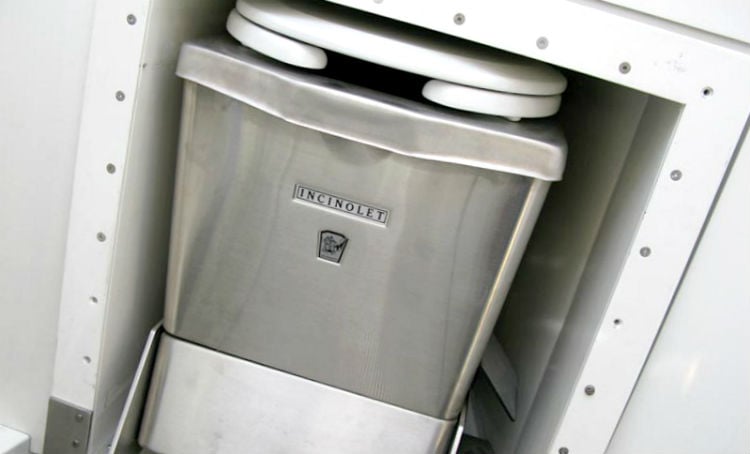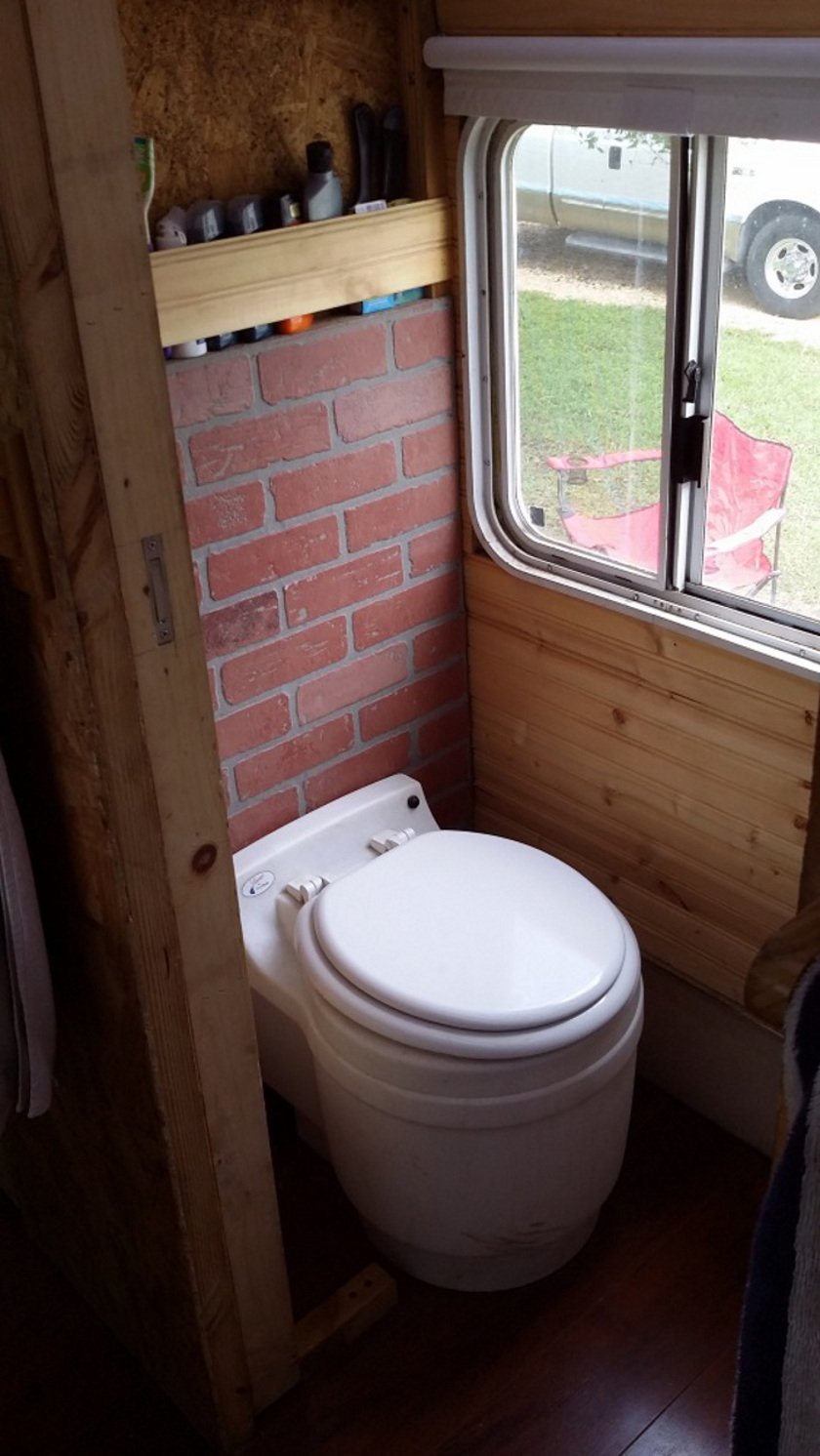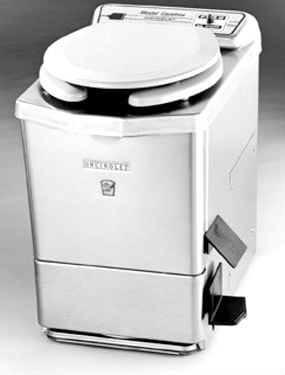RVing is great fun, but dealing with your holding tanks isn’t. Thankfully, these two new waterless RV toilets—the Laveo by Dry Flush and the Incinolet—are making RV waste management a little easier.

The Incinolet is just one of the units we have included in this feature (seen here). The other is the Laveo by Dry Flush. Read below for all the details.
Should you decide to convert your RV toilet to one of these waterless models, you can still use your RV toilet paper of choice. As a bonus, you can say goodbye to your black tank forever.

The Laveo by DryFlush
Laveo by Dry Flush
If you’ve ever had infants around the house, you know about the miracle of the Diaper Genie. The Laveo by Dry Flush works using the same concept. Instead of relying on water and chemicals to manage human waste, this unit simply bags it up and transfers it to an odor-free cartridge.
The Laveo made its debut in 2014 and is rapidly gaining fans for many reasons. For one, the dry flush is very easy to operate.
According to the company, “There is no need for wastewater/black water pumping/dumping or adding of chemicals. Waste is automatically encapsulated during a “flush” and hidden in a lined container under the seat. When the cartridge is expended, lift up the toilet seat and the trim piece just under it. Lift out the liner bag containing wrapped waste. You will never see or smell waste at any time.”
The Dry Flush doesn’t need to be installed, vented or require constant electricity in order to operate. It’s only moving part relies on an electrically charged battery to operate the unit. About every 500 hours you can recharge it with any 120v outlet.
The unit costs about the same as a composting toilet, starting at about $800. The downside of the Dry Flush is that it requires you to buy proprietary cartridges. Three at a time cost $49.95 and are currently available from the company and a growing list of retailers. Each cartridge lasts for about 17 uses.
The Incinolet
The Incinolet gives a whole new meaning to the term “light a fire under your seat.” Instead of relying on water to manage waste, the Incinolet incinerates it with the push of a button. The end result is less than one tablespoon of clean, germ-free ash for every 3 or 4 uses.

The Incinolet simply works when you push a button to incinerate waste held in a special chamber.
The Dallas, Texas-based company has been manufacturing it for more than 40 years. Typically only found in tiny homes and serious expedition vehicles like the Kiravan, the Incinolet is gaining fans within the RV consumer market as well.
How the Incinolet works
Like the Dry-Flush, you’ll need the company’s proprietary bowl liners to use the device. Place one of these specially coated liners into the bowl before use and the shiny toilet never needs cleaning or maintenance.
The Incinolet works when you push a button to incinerate waste held in a special chamber. A blower and heater kickstarts the 1200-degree Fahrenheit incineration process and a small amount of smoke gets sent through an odor control catalyst similar to ones found in automobile. The four-inch exhaust vent required allows the smoke to escape.
The heater cycles on and off for 60 minutes to provide optimum combustion and the blower continues to run for about 30 minutes to cool the incineration chamber. Even when the process is happening, the toilet can be used during the nearly two-hour cycle. Although the Incinolet requires electricity, it only consumes about one kilowatt hour per cycle.
Like other waterless RV toilets, such as a composting unit, you won’t need a black tank with the Incinolet. This stainless steel throne never needs draining and can be used in any climate. It’s more complicated to install than the Dry-Flush, but the benefit is you’ll only deal with a minuscule amount of ash.
The Incinolet starts at $1,800 depending on how and where it will be used (different models are available for RV, marine, cabin and other types of installations).
Have you tried one of these waterless RV toilets? We’d love to hear your feedback!

No interest in anything that uses “proprietary” liners or cartridges. There is no competition to reduce cost (especially with such a small market segment) and if the company goes belly up your investment is rendered useless.
That did cross my my mind as well, but I’m confident in both manufacturers. The Incinolet has been around for over 40 years and with the state of the environment and huge demand for water in many areas, I doubt the demand for waterless appliances like this will go away.
I so agree with you. The “diaper genie” type potty then allows you to place your waste in a campground dumpster…why not read up on and use a simple “sawdust toilet?” If you use plain, pine hamster litter and any waterproof kitchen garbage liner bag, you can keep it odor-free and easy-to-dispose without buying a special toilet (a -gallon bucket witn a “bucket seat” works fine) or any special proprietary liners/cartridges, etc. It is equal to tossing out baby diapers, adult diapers, or this “dry” diaper-genie type tube of “encapsulated” waste. Any area that allows you to dispose of diapers allows disposal of this waste.
Though I wouldn’t discuss it much with people until I tested their opinions carefully…some people go off the rails when this subject arises…they’d likely hate the diaper-genie potty for the same reasons. They totally think waterless waste disposal is somehow filthy and wrong. It’s neither.
How if it’s possible can I use an incinerating toilet in a wet room I saw a photo where it looks like it’s stored under cabinet and pulls out what if it’s bented how is that possible I’m curious because I have a wet room and I like to switch to one of these incinerator toilets
i baught a 1970 and was thinking about the same thing I think I am looking at tank less on demand hot water
The tank less on demand hot water system needs a tank of fresh water to supply the tank less on demand hot water system.
My suggestion to Kurt is do some more research,, the tank-less system i have been using for over 12 years has NO fresh water tank supply, it is electric, per chance your comment was meant for gas.
Where does the water come from that flows through the tankless water heater? If not from a city (well) water line, then from a fresh water storage tank that you have previously filled.
Dave, can you or a reader please comment on composting toilets? The Incinolet sounds fabulous but the price…yikes! Manufacturers should offer some of these as an option.
Chris you might want to comment on Dave’s blog post directly so he sees your question.
I have been using the Nature’s Head composting toilet for nearly two years and love it. It has taken me awhile to learn the best way to prep the coco coir (it should be bone dry, not wet as the manufacturer recommends). The Dry Flush sounds like an environmental nightmare. Encasing each toilet trip in plastic?? That’s even worse than using water to flush. And as someone pointed out, you’re forever obligated to buy their proprietary supplies. No way. Coco coir is a sustainable substance.
I agree, Christie. These 2 waterless ideas are worse than composting by a long shot. And the heat from incinolet? Can’t believe it won’t heat up the cabin some – for 2 hours. No tanks!
How about using compostable bags
I love my dry flush! Works great for just me and my wife while on the road.
I bought it at https://www.shoptinyhouses.com/products/laveo-dry-flush-toilet
Using the Laveo, where does one drop the nicely wrapped packages of human waste? Surely it cannot be legal to just put them in a dumpster?
Is it illegal to put a baby’s diaper in the trash?
For a non-electric, no water toilet that can’t be beat on price, consider a 5 gallon bucket lined with plastic bags and kitty litter or wood chips/sawdust.
One for the pickup. One for the motorhome. With a little work, easy to build. Less than $25 for everything. Used the motorhome’s twice last winter. While winterized.
Now that’s a smart money saving idea!
We have a composting toilet. When we have a large enough campfire, we can burn our accumulated dried waste. I wouldn’t roast marshmallows over the fire though!
I’ve used an Incinolet in a building for years at a location that doesn’t have access to the city sewer or water, unless I spend thousands to extend it and hook up. Its funny that people refuse to consider it due to proprietary supplies. Its a box of paper liners that are priced not much higher than any other paper products, and you get enough to last for months. This is opposed to all those low priced, quality made RV paper supplies, chemical, cleaners we all have to buy. No heat radiates out from the unit and they should last for years if the ash pan is emptied regularly. I dont think I would replace the RV toilet unless there was lack of water or place to dump the tank. The Incinolet does require its own 20 or 30 amp circuit depending on which model you get and it does need a vent, similar to a dryer. For RV use, maybe the other water less toilet would be more practical if one had to discard the usual toilet. But, if the Incinolet was more suitable for your situation, its well made, works as advertised, should last forever and parts are readily available if you need them. If you call the support number, someone will answer.
I use compostable corn “bags” and pine kitty litter. Tie up the bag, bury. Is this wrong?
I am a senior and am looking to buy a conversion van. As a girl I used an outhouse at our ranch before we had a bathroom built on our old house. It was fine but I really like the idea of no black water and I also read some places of long term parking for tiny houses would rather not have compost waste. I would pay more if I could for an incinolet toilet so the waste would be much easier to deal with. However I can easily use a 5 gallon bucket and leaves. Lol.
I love to travel and this would be one less headache “dump.”
I also love an outdoor shower but love the idea of a pan with a wood grate in the hallway. A round slot in the ceiling for a removable curtain would be nice too. I also would like to see more single Murphy beds. The loft bed in the old vw’s appeals too.
Keep the aisle clear, galley kitchen, aisle shower, incinerator toilet, single bed, tall, off grid, on demand water heater, large fresh water tank, no microwave, desk/work area, storage instead of couches and no bed across the back.
When I look at conversion vans or class B. I see a lack of single living units, with only the young in mind or families. Surely these can be outfitted more reasonably with the need for affordable tiny housing and adventure included!
Thanks
composting toilets are illegal in Utah
The Incinolet is really a great product, however, the dedicated 20 Amp, 120 VAC, 2,000 watts of power for a 2-hour cycle would make the cost huge. It would work well on very large motor homes with 50 Amp / 220 VAC shore power. Most small RVs (Class B’s) and boats only have generators that reach 2,000 watts (startup) with 1600 “Running” watts. There is a trade-off with the inconvenience of Black Water tank maintenance vs. the Incinolet system. The current state of Solar Power now incorporates a Full Sine Wave of regulated 120 VAC power but they couldn’t handle the power demands of an Incinolet system. Think of a toaster oven and a hot water kettle on at the same time for two hours and you get an idea of the kind of electrical power required. One further note: most 20 Amp electrical circuits aren’t designed to handle a full 20 Amp load continuously. The circuit breakers are designed to handle roughly 80-85% of that current, i.e., 16-17 amps continuously leaving 3-4 Amps as a safety margin. As more and more RVs and Motor Homes make more and more demands on electrical energy, it’s only a question of time when the RV Resorts start adding an “Electrical Power Surcharge”. IMHO.
Using lime in the composting toilet would it damage anything, this was used in outhouses to eliminate odor and speed up composting?
If you have a composting toilet in an RV would using Lime hurt anything in the toilet it’s been used for years in outhouses
We installed an Ecojohn. They have a new waterless incinerating toilet model called Tinyjohn, and it only draws 20W at 12VDC. We have used it for 4 months and are super happy, we only cleaned out ashes once. A urine cycle takes 25 min and a waste cycle about an hour. In our opinion, this is by far the best toilet for an RV (small or big). We had a black water tank before, and we have experience with composting toilets; this is such an upgrade.
Would you need a battery for sole use of the toilet and does it smell up the motorhome
The Ecojohn starts at $3,385.00 according to their web site. There’s the real trade-off.
We had the unfortunate luck of staying next to an rv using an incinerating toilet and it had a very foul odor coming from its 4 inch vent and it ran for four hours at a time: morning, noon and night. It also made a high pitched whining sound. It ruined our Labor Day camping weekend. The occupants of the rv said they had no control on when the toilet operated. God Bless the people that are downwind to this type of toilet. It might be very eco-friendly but foul smelling to your neighbors.
I just did the math on the bags for the dry toiltet for the year for us and I will stick with the composting toilet with an exhaust vent.
As for the Incinolet toilet, I read they have made some improvements on the exhaust and noise. It is still out of my price range.
Can you tell me what the toilet cost.